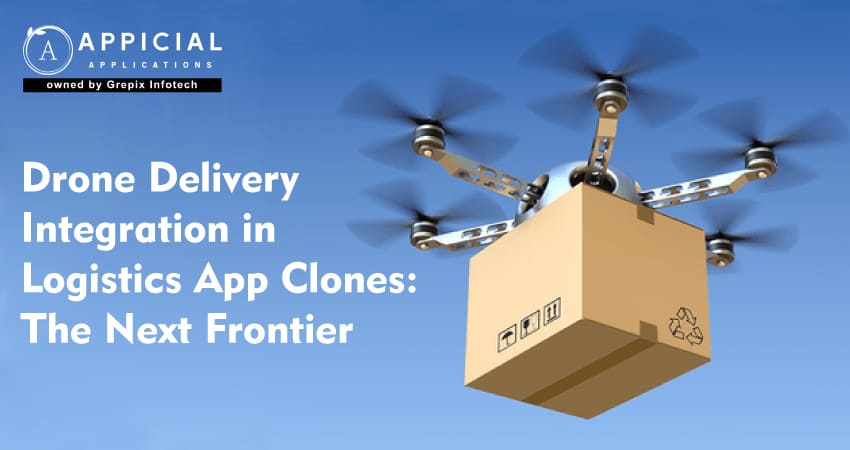
Drone Delivery Integration in Logistics App Clones: The Next Frontier
Let’s talk about something straight out of a movie: drones dropping off your online order minutes after you click "Buy Now." Cool, right?
Well, it’s not just futuristic fantasy anymore.
Drone delivery is slowly creeping into reality, not just for big corporations, but also for small businesses and startups jumping on the trend. The world’s waking up to the potential of what’s now being called the aerial delivery system, and it’s rewriting how we think about speed, efficiency, and innovation in logistics.
And here’s where it gets more interesting: app clones. You see, the market for logistics app clones is booming. Startups are replicating the functionality of successful delivery apps like Uber Freight, Postmates, or DoorDash. And now, they’re throwing drones into the mix. We're talking full-blown drone integration into apps that are already up and running (or cloned versions of them). It’s a beautiful blend of smart tech and smart business.
The shift to a drone logistics app environment isn’t just about speed. It's about rethinking how we deliver everything, from medicine to groceries, from mountaintop villages to traffic-clogged cities.
Let’s unpack how this revolution is taking off (pun intended).
Drone deliveries are no longer sci-fi; they're here, buzzing just above your doorstep. This blog dives into how drone integration is flipping the delivery industry on its head, especially in the world of logistics app clones. From faster deliveries to fewer carbon emissions, the sky’s literally the limit. We'll cover everything from benefits to red tape, ending with a look into the future and a company making this tech transition easier than ever: Appicial Applications.
What are the Benefits and Challenges?
The Perks of Going Airborne
So, what’s the big deal with adding logistics app clone drone integration? Quite a lot, actually.
1 Speed Like Never Before
A package that would normally take 45 minutes in city traffic? A drone gets it there in 10. We’re not even exaggerating. Drones fly over all that ground-level chaos, traffic jams, potholes, bad roads, you name it.
2 Cost Efficiency in the Long Run
Sure, drones aren’t cheap upfront. But over time? Way cheaper than managing fleets of drivers and vehicles. Fewer breakdowns, no gas bills, less wear-and-tear maintenance. For bulk orders and last-mile deliveries, drones become a high ROI asset.
3 Environmentally Friendly
Drones don’t guzzle gas. They’re electric, which means they’re one of the greenest delivery methods out there. Integrating them into a drone logistics app can also be a great PR move for eco-conscious businesses.
4 Access to Hard-to-Reach Areas
Rural zones, disaster-hit regions, or just plain off-the-grid towns, drones go where roads don’t. It’s not just convenient. In emergencies, it can be life-saving.
5 Wow Factor (Yep, That Counts)
Want to stand out in a crowded app marketplace? Add drone integration to your logistics app clone and watch your brand image soar. Customers love innovation, especially when it saves them time.
The Catch (There’s Always One)- Challenges
1 Limited Payload Capacity
This one’s a buzzkill right out of the gate. Picture this: You order a big sack of dog food, and your app says it'll be arriving by drone. Cool, right? Except, it’s not coming. Why? That 30-pound sack is way outside what most delivery drones can carry.
The truth is, most commercial drones can only manage between 2 to 5 kilograms (about 4.5 to 11 pounds). That’s barely a full grocery bag. So, while aerial delivery systems are great for meds, documents, snacks, or even a bottle of wine, they’re not ideal for bulky or heavy items. You need to tailor your delivery catalog to suit this limitation, or risk customer disappointment.
That means anyone developing a drone logistics app has to get strategic. Maybe that means building in weight limits during checkout. Or restricting drone delivery options based on product size. Either way, managing expectations here is key.
2 Weather Dependency
Drones are like fair-weather friends , they’re awesome when skies are clear, but a little unreliable when things get stormy.
Unlike trucks or bikes, drones are far more sensitive to environmental conditions. A gusty wind? That can knock a drone off course. Sudden downpour? Could short-circuit the whole operation. Snow or hail? Forget about it.
And here's the kicker , most logistics app clones aren't built to factor in weather disruptions by default. That adds another layer of complexity. You’ll need dynamic scheduling, backup delivery options, and possibly even automated rerouting protocols baked into your app's backend.
So, unless you're only delivering in always-sunny San Diego (lucky you), weather remains a serious variable. Any smart drone integration strategy needs to account for it.
3 Battery Life Constraints
Let’s talk battery anxiety. You know how your phone starts dying after a couple of hours without a charge? Drones are the same, except the stakes are way higher. You don’t want a delivery drone dropping out of the sky mid-route because it ran out of juice.
Most commercial drones only have a flight time of 30 to 45 minutes. That’s round-trip. Factor in the load weight, wind resistance, and flight path complexity, and you’re dealing with a pretty tight delivery radius.
For urban deliveries, this might be fine. But if your drone logistics app services suburban or rural zones, you'll either need longer-lasting drones or strategically placed recharging hubs.
Some businesses are experimenting with battery-swapping stations or solar-powered recharging pads, but those solutions aren’t cheap, and they’re still new tech. Bottom line: you have to design your delivery network with this limitation front and center.
What are the Regulatory Considerations That You Cannot Afford to Overlook?
Now, let’s get into the bureaucracy. Because, of course, governments love to regulate flying robots. Who could blame them?
Legal Hurdles in Drone Deliveries
Almost every country has rules about flying drones. These usually cover:
- Altitude and range limits
- No-fly zones (near airports, government buildings, etc.)
- Pilot licenses or certifications
- Line-of-sight requirements
- Night flying restrictions
So, if you’re planning to roll out a drone logistics app, you can’t skip legal due diligence. Skipping it could mean major fines, or worse, grounded drones.
Varies by Region
The U.S. FAA has its rules. The EU has theirs. India, UAE, Singapore all have slightly different frameworks. So if your logistics app clone is targeting global users, you’ll need adaptive compliance systems built into your app.
Also Read: On-Demand Drone Delivery App Development: Transforming The Future Of Logistics
Air Traffic Integration
As drones become more common, they’ll need to play nice with existing aircraft systems. That’s a whole new level of integration, with AI-powered air traffic management systems and cloud-based tracking.
Companies pioneering in this area include SkyGrid and AirMap, but for most developers of logistics app clones, partnering with a reliable tech provider who understands these nuances is key.
Future Prospects
Let’s pause and ask: Is this a passing trend or the next default mode of delivery?
Spoiler alert: It’s the latter.
AI-Driven Drones Are the Future
We’re seeing the birth of autonomous drones, machines that don’t just follow coordinates but react to live situations. Obstacle avoidance, mid-flight rerouting, and energy optimization are no longer R&D concepts.
For a drone logistics app, this means the delivery process can eventually become almost human-free, reducing operational complexity and cost.
Drone Swarms for High Volume
Amazon and Walmart are already testing drone swarms, coordinated fleets of drones delivering multiple packages simultaneously. For developers and entrepreneurs working on a logistics app clone, this opens up advanced scalability. Imagine a backend dashboard where you control 20 drones at once.
Blockchain for Drone Delivery Logs
With increasing concerns about transparency and tracking, blockchain could soon play a big role. Timestamped delivery logs, route verifications, even smart contracts , all could be part of the drone integration toolset.
Cross-App Integration
In the near future, we may see aerial delivery systems integrated across different platforms, ride-hailing, e-commerce, food delivery, and even healthcare. The delivery drone won’t just be a standalone gimmick; it’ll be part of a bigger ecosystem of real-time logistics.
So if you’re building or buying a logistics app clone, think ahead. Make it drone-compatible from Day 1.
Conclusion: Let Appicial Applications Elevate Your Drone Journey
If you're reading this and thinking, “Okay, I want in”, you’re not alone. But also, you don't have to do it solo.
This is where Appicial Applications comes into play. They specialize in high-quality logistics app clones that are customizable, scalable, and yes, ready for drone integration.
Whether you're a startup looking to disrupt local delivery or a larger enterprise ready to scale nationwide with an aerial delivery system, Appicial has the tech know-how and product base to back you up. From backend logistics to sleek user interfaces, they ensure your transition to a drone logistics app is as smooth as a well-balanced drone flight.
In short? If the sky’s the limit, Appicial Applications can get you there.
So, what’s your next move? A delivery fleet stuck in traffic or drones cutting through clouds? The future’s airborne, and now’s the time to take off.
Looking out to start your own Logistics venture? Try out our GTA Logistics app, the easiest way to kick-start your logistics business.Author's Bio

Vinay Jain is the Founder at Grepix Infotech and brings over 12 years of entrepreneurial experience. His focus revolves around software & business development and customer satisfaction.
Back to blog list




